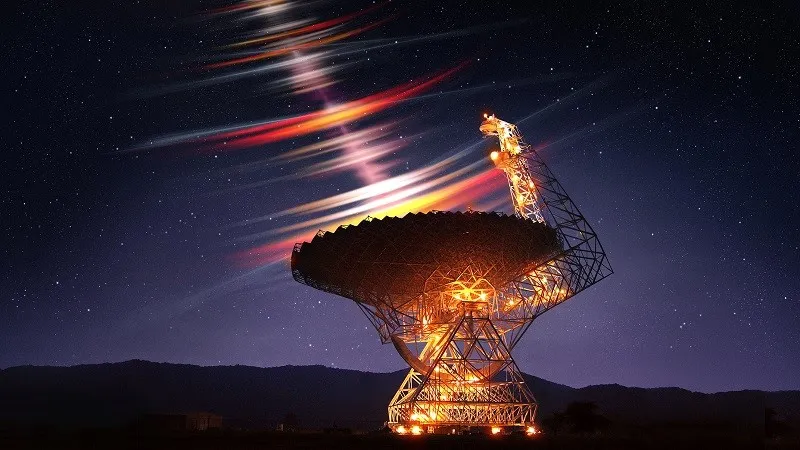The U.S. National Science Foundation National Radio Astronomy Observatory (NSF NRAO) has received funding to expand its study of an invisible—and crucial—scientific and technological resource: the radio spectrum.
Recent News
Largest Oort Cloud Comet Ever Observed Reveals Its Secrets with ALMA’s Powerful Gaze
A team of astronomers has made a groundbreaking discovery by detecting molecular activity in comet C/2014 UN271 (Bernardinelli-Bernstein)—the largest and second most distantly active comet ever observed from the Oort Cloud.
Unusual stellar nurseries near our galaxy’s center puzzle scientists
New research led by Dr. James De Buizer at the SETI Institute and Dr. Wanggi Lim at IPAC at Caltech revealed surprising results about the rate at which high-mass stars form in the galactic center of the Milky Way.
New type of Fast Radio Burst discovered in Green Bank Telescope data

Artist’s impression of the discovery of microsecond Fast Radio Bursts being observed by the Green Bank Telescope. Incoming radio waves are shown as white, red, and orange streaks that follow each other in rapid succession. The long red streaks are the previously known millisecond flashes. (c) Daniëlle Futselaar/www.artsource.nl
An international team of researchers have discovered radio pulses from the distant universe that last only millionths of a second. They found these microsecond bursts after a meticulous examination of archival data from the National Science Foundation’s Green Bank Telescope. It’s unclear how the ultrafast bursts were created. The researchers published their findings in Nature Astronomy.
Fast radio bursts (FRBs) are unpredictable, extremely short flashes of radio waves far beyond our Milky Way. They are possibly caused by magnetic neutron stars, also known as magnetars. The first bursts were discovered in 2007. So far, most bursts last longer than a thousandth of a second and emit as much energy as our sun generates in a day.
In 2022, researchers at the University of Amsterdam and ASTRON hypothesized that there might be bursts that would last not thousandths, but only millionths of a second. “During our group meetings, we often talked about it”, says Mark Snelders, PhD candidate at ASTRON and the University of Amsterdam (the Netherlands), who was in charge of the research that uncovered the ultra-fast radio bursts. “By coincidence, I found out that there was a public dataset that we could use for this.”
Watch a presentation by Mark for the Green Bank Observatory about this science.
Five hours of data – and millions of images
The researchers accessed the public data archive from the Breakthrough Listen project, which uses the Green Bank Telescope to search for extraterrestrial life. They focused on five hours of data from FRB 20121102A, located some three billion light years away, towards the Auriga constellation.
The researchers divided each second of the first thirty minutes of data into half a million individual images. Next, they used software filters and machine learning to search for outliers. Through this meticulous process, they discovered eight ultra-fast bursts that lasted only ten millionths of a second or less.
Now that the first ultra-fast microsecond source has been detected, researchers expect to find more. However, finding them may be easier said than done, as some data files are not detailed enough to cut into half a million pieces per second.
The Green Bank Observatory is supported by the National Science Foundation and is operated by Associated Universities, Inc.
Read more at the Netherlands Research School for Astronomy.
Media Contact:
Jill Malusky, NRAO & GBO News & Public Information Manager
[email protected]
This news article was originally published on the GBO website on October 19, 2023.
Recent News
NSF NRAO Leads Critical Spectrum Studies to Safeguard Radio Astronomy
The U.S. National Science Foundation National Radio Astronomy Observatory (NSF NRAO) has received funding to expand its study of an invisible—and crucial—scientific and technological resource: the radio spectrum.
Largest Oort Cloud Comet Ever Observed Reveals Its Secrets with ALMA’s Powerful Gaze
A team of astronomers has made a groundbreaking discovery by detecting molecular activity in comet C/2014 UN271 (Bernardinelli-Bernstein)—the largest and second most distantly active comet ever observed from the Oort Cloud.
Unusual stellar nurseries near our galaxy’s center puzzle scientists
New research led by Dr. James De Buizer at the SETI Institute and Dr. Wanggi Lim at IPAC at Caltech revealed surprising results about the rate at which high-mass stars form in the galactic center of the Milky Way.
